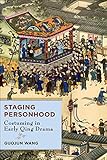Staging Personhood : Costuming in Early Qing Drama / Guojun Wang.
Material type: TextPublisher: New York, NY : Columbia University Press, [2020]Copyright date: ©2020Description: 1 online resource : 36 b&w figuresContent type:
TextPublisher: New York, NY : Columbia University Press, [2020]Copyright date: ©2020Description: 1 online resource : 36 b&w figuresContent type: - 9780231191906
- 9780231549578
- Chinese drama -- Qing dynasty, 1644-1912 -- History and criticism
- Clothing and dress in literature
- Clothing and dress -- Social aspects -- China
- Clothing and dress -- China -- History -- Ming-Qing dynasties, 1368-1912
- Costume -- China -- History -- Ming-Qing dynasties, 1368-1912
- Theater and society -- China -- 17th century
- Theater and society -- China
- Theater -- China -- History -- 17th century
- LITERARY CRITICISM / Drama
- online - DeGruyter
| Item type | Current library | Call number | URL | Status | Notes | Barcode | |
|---|---|---|---|---|---|---|---|
 eBook
eBook
|
Biblioteca "Angelicum" Pont. Univ. S.Tommaso d'Aquino Nuvola online | online - DeGruyter (Browse shelf(Opens below)) | Online access | Not for loan (Accesso limitato) | Accesso per gli utenti autorizzati / Access for authorized users | (dgr)9780231549578 |
Browsing Biblioteca "Angelicum" Pont. Univ. S.Tommaso d'Aquino shelves, Shelving location: Nuvola online Close shelf browser (Hides shelf browser)

|

|

|

|

|

|

|
||
| online - DeGruyter A Revolution in Three Acts : The Radical Vaudeville of Bert Williams, Eva Tanguay, and Julian Eltinge. | online - DeGruyter A Slave Between Empires : A Transimperial History of North Africa / | online - DeGruyter Art of Memories : Curating at the Hermitage / | online - DeGruyter Staging Personhood : Costuming in Early Qing Drama / | online - DeGruyter City of Workers, City of Struggle : How Labor Movements Changed New York / | online - DeGruyter Rewriting Indie Cinema : Improvisation, Psychodrama, and the Screenplay / | online - DeGruyter Kingly Crafts : The Archaeology of Craft Production in Late Shang China / |
Frontmatter -- Contents -- Acknowledgments -- INTRODUCTION. Costuming as Method -- CHAPTER ONE. Ways to Dress and Ways to See -- CHAPTER TWO. Across Genders and Ethnicities -- CHAPTER THREE. Between Family and State -- CHAPTER FOUR. The Chaste Lady Immortal of Seamless Stitching -- CHAPTER FIVE. From State Attire to Stage Prop -- EPILOGUE. Dressing Other and Self -- Appendix 1: Extant Editions of A Ten- Thousand- Li Reunion -- Appendix 2: Scene Synopsis of A Ten- Thousand- Li Reunion -- Notes -- Works Cited -- Index
restricted access online access with authorization star
http://purl.org/coar/access_right/c_16ec
After toppling the Ming dynasty, the Qing conquerors forced Han Chinese males to adopt Manchu hairstyle and clothing. Yet China’s new rulers tolerated the use of traditional Chinese attire in performances, making theater one of the only areas of life where Han garments could still be seen and where Manchu rule could be contested.Staging Personhood uncovers a hidden history of the Ming–Qing transition by exploring what it meant for the clothing of a deposed dynasty to survive onstage. Reading dramatic works against Qing sartorial regulations, Guojun Wang offers an interdisciplinary lens on the entanglements between Chinese drama and nascent Manchu rule in seventeenth-century China. He reveals not just how political and ethnic conflicts shaped theatrical costuming but also the ways costuming enabled different modes of identity negotiation during the dynastic transition. In case studies of theatrical texts and performances, Wang considers clothing and costumes as indices of changing ethnic and gender identities. He contends that theatrical costuming provided a productive way to reconnect bodies, clothes, and identities disrupted by political turmoil. Through careful attention to a variety of canonical and lesser-known plays, visual and performance records, and historical documents, Staging Personhood provides a pathbreaking perspective on the cultural dynamics of early Qing China.
Mode of access: Internet via World Wide Web.
In English.
Description based on online resource; title from PDF title page (publisher's Web site, viewed 25. Jun 2024)


